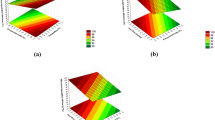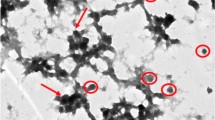Abstract
Propolis presents several health benefits due to the presence of bioactive compounds, mainly phenolic compounds; however, its application in food is limited due to undesirable odor and low water solubility. The bioactive compounds are usually susceptible to degradation by exposure to light, heat, or oxygen or by interaction with other compounds, which may limit its biological activity. The study aimed the propolis extract microencapsulation using rice, pea, soybean, and ovoalbumin proteins as wall material by spray drying and to analyze their in vitro digestion. The propolis extract presented a high concentration of apigenin. Encapsulation efficiency was greater than 70%, and it was maintained the antioxidant activity of propolis (88% inhibition of DPPH for propolis extract and > 73% for the microparticles). The DSC, ATR-FTIR, and X-ray diffraction techniques confirmed the encapsulation. The microparticles showed different shapes, sizes, and physical characteristics. The microparticles encapsulated with pea protein could be used in formulations of Minas Frescal cheese due to the controlled released, whereas the other microparticles could be used in pudding formulations.





Similar content being viewed by others
References
Ahn, M. R., Kumazawa, S., Usui, Y., Nakamura, J., Matsuka, M., Zhu, F., & Nakayama, T. (2007). Antioxidant activity and constituents of propolis collected in various areas of China. Food Chemistry, 101(4), 1383–1392.
Alishahi, A., Mirvaghefi, A., Tehrani, M. R., Farahmand, H., Shojaosadati, S. A., Dorkoosh, F. A., & Elsabee, M. Z. (2011). Shelf life and delivery enhancement of vitamin C using chitosan nanoparticles. Food Chemistry, 126(3), 935–940.
Amagliani, L., O’Regan, J., Kelly, A. L., & O’Mahony, J. A. (2017). Composition and protein profile analysis of rice protein ingredients. Journal of Food Composition and Analysis, 59, 18–26.
Andrade, J. K. S., Denadai, M., de Oliveira, C. S., Nunes, M. L., & Narain, N. (2017). Evaluation of bioactive compounds potential and antioxidant activity of brown, green and red propolis from Brazilian northeast region. Food Research International, 101, 129–138.
AOAC (1995). Official methods of analysis of the Association of Official Analytical Chemistry (16th Ed). In In AOAC International, 1141. Washington.
Bhandari, B. R., Senoussi, A., Dumoulin, E. D., & Lebert, A. (1993). Spray drying of concentrated fruit juices. Drying Technology, 11(5), 1081–1092.
Brand-Williams, W., Cuvelier, M.-E., & Berset, C. (1995). Use of a free radical method to evaluate antioxidant activity. Lebens Wiss Techn (LWT), 28(1), 25–30.
Bruschi, M. L., Cardoso, M. L. C., Lucchesi, M. B., & Gremião, M. P. D. (2003). Gelatin microparticles containing propolis obtained by spray-drying technique: preparation and characterization. International Journal of Pharmaceutics, 264(1-2), 45–55.
Busch, V. M., Pereyra-Gonzalez, A., Šegatin, N., Santagapita, P. R., Poklar Ulrih, N., & Buera, M. P. (2017). Propolis encapsulation by spray drying: characterization and stability. Lebens Wiss Techn (LWT), 75, 227–235.
Çam, M., Içyer, N. C., & Erdoğan, F. (2014). Pomegranate peel phenolics: microencapsulation, storage stability and potential ingredient for functional food development. Lebens Wiss Techn (LWT), 55(1), 117–123.
Choi, K. O., Ryu, J., Kwak, H. S., & Ko, S. (2010). Spray-dried conjugated linoleic acid encapsulated with Maillard reaction products of whey proteins and maltodextrin. Food Science and Biotechnology, 19(4), 957–965.
Costa, A. M. M., Nunes, J. C., Lima, B. N. B., Pedrosa, C., Calado, V., Torres, A. G., & Pierucci, A. P. T. R. (2015). Effective stabilization of CLA by microencapsulation in pea protein. Food Chemistry, 168, 157–166.
Do Nascimento, T. G., da Silva, P. F., Azevedo, L. F., da Rocha, L. G., Porto, I. C. C. de M., Lima e Moura, T. F. A. et al. (2016). Polymeric nanoparticles of Brazilian red propolis extract: preparation, characterization, antioxidant and Leishmanicidal activity. Nanoscale Research Letters, 11 (301). DOI https://doi.org/10.1186/s11671-016-1517-3.
Donhowe, E. G., Flores, F. P., Kerr, W. L., Wicker, L., & Kong, F. (2014). Characterization and in vitro bioavailability of β-carotene: effects of microencapsulation method and food matrix. Lebens Wiss Techn (LWT), 57(1), 42–48.
dos Reis, A. S., Diedrich, C., de Moura, C., Pereira, D., Almeida, J. d. F., da Silva, L. D., et al. (2017). Physico-chemical characteristics of microencapsulated propolis co-product extract and its effect on storage stability of burger meat during storage at 15 °C. Lebens Wiss Techn (LWT), 76 (B), 76, 306–313.
Elbaz, N. M., Khalil, I. A., Abd-Rabou, A. A., & El-Sherbiny, I. M. (2016). Chitosan-based nano-in-microparticle carriers for enhanced oral delivery and anticancer activity of propolis. International Journal of Biological Macromolecules, 92, 254–269.
Fang, Z., & Bhandari, B. (2012). Comparing the efficiency of protein and maltodextrin on spray drying of bayberry juice. Food Research International, 48(2), 478–483.
Ghorbanzade, T., Jafari, S. M., Akhavan, S., & Hadavi, R. (2017). Nano-encapsulation of fish oil in nano-liposomes and its application in fortification of yogurt. Food Chemistry, 216, 146–152.
Graikou, K., Popova, M., Gortzi, O., Bankova, V., & Chinou, I. (2016). Characterization and biological evaluation of selected Mediterranean propolis samples. Is it a new type? Lebens Wiss Techn (LWT), 65, 261–267.
Gutiérrez, T. J., Álvarez, K. (2017). Biopolymers as microencapsulation materials in the food industry. In: Advances in Physicochemical Properties of Biopolymers: Part 2. Martin Masuelli, and Denis Renard (Eds). Bentham Science Publishers. EE.UU. ISBN: 978–1–68108-545-6. E ISBN: 978–1–68108-544-9, 2017. pp. 296–322. doi: https://doi.org/10.2174/9781681085449117010009.
Hao, Z., Yuying, F., Fuge, N., Zeya, L., Chujie, B., Bing, J., Guowen, C., & Xiaomeng, L. (2018). Enhanced antioxidant activity and in vitro release of propolis by acid-induced aggregation using heat-denatured zein and carboxymethyl chitosan. Food Hydrocolloids, 81, 104–112.
Hoffmann, J. F., Zandoná, G. P., Santos, P. S. D., Dallmann, C. M., Madruga, F. B., Rombaldi, C. V., & Chaves, F. C. (2017). Stability of bioactive compounds in butiá (Butia odorata) fruit pulp and nectar. Food Chemistry, 237, 638–644.
IBGE - Brazilian Institute of Geography and Statistics. Apiculture. (2013). http://www.ibge.gov.br/home/estatistica/pesquisas/sintese.php./ Accessed 11 May 2017.
Jayasundera, M., Adhikari, B., Adhikari, R., & Aldred, P. (2011a). The effect of protein types and low molecular weight surfactants on spray drying of sugar-rich foods. Food Hydrocolloids, 25(3), 459–469.
Jayasundera, M., Adhikari, B., Adhikari, R., & Aldred, P. (2011b). The effects of proteins and low molecular weight surfactants on spray drying of model sugar-rich foods: powder production and characterisation. Journal of Food Engineering, 104(2), 259–271.
Jia, Z., Dumont, M.-J., & Orsat, V. (2016). Encapsulation of phenolic compounds presentin plants using protein matrices. Food Bioscience, 15, 87–104.
Joye, I. J., & McClements, D. J. (2014). Biopolymer-based nanoparticles and microparticles: fabrication, characterization, and application. Current Opinionin Colloid InterfaceScience, 19(5), 417–427.
Kuck, L. S., & Noreña, C. P. Z. (2016). Microencapsulation of grape (Vitis labrusca var. Bordo) skin phenolic extract using gum Arabic, polydextrose, and partially hydrolyzed guar gum as encapsulating agents. Food Chemistry, 194, 569–576.
Kuck, L. S., Wesolowski, J. L., & Noreña, C. P. Z. (2017). Effect of temperature and relative humidity on stability following simulated gastro-intestinal digestion of microcapsules of Bordo grape skin phenolic extract produced with different carrier agents. Food Chemistry, 230, 257–264.
Malheiros, P. d. S., Sant’Anna, V., Barbosa, M. d. S., Brandelli, A., & Franco, B. D. G. d. M. (2012). Effect of liposome-encapsulated nisin and bacteriocin-like substance P34 on Listeria monocytogenes growth in minas frescal cheese. International Journal of Food Microbiology, 156(3), 272–277.
Maruf, A., Mst., S. A., Jin-Cheol, L., & Jong-Bang, E. (2010). Encapsulation by spray drying of bioactive components, physicochemical and morphological properties from purple sweet potato. Lebens Wiss Techn (LWT), 43, 1307–1312.
Moser, P., Telis, V. R. N., Neves, N. d. A., García-Romero, E., Gómez-Alonso, S., & Hermosín-Gutiérrez, I. (2017). Storage stability of phenolic compounds in powdered BRS Violeta grape juice microencapsulated with protein and maltodextrin blends. Food Chemistry, 214, 308–318.
Nesterenko, A., Alric, I., Silvestre, F., & Durrieu, V. (2013). Review. Vegetable proteins in microencapsulation: a review of recent interventions and their effectiveness. Industrial Crops and Products, 42, 469–479.
Neto, R. M. S., Tintino, S. R., da Silva, A. R. P., Costa, M. d. S., Boligon, A. A., Matias, E. F. F., et al. (2017). Seasonal variation of Brazilian red propolis: antibacterial activity, synergistic effect and phytochemical screening. Food and Chemical Toxicology, 107, 572–580.
Nori, M. P., Favaro-Trindade, C. S., Alencar, S. M., Thomazini, M., Balieiro, J. C. C., & Castillo, C. J. C. (2011). Microencapsulation of propolis extract by complex coacervation. Lebens Wiss Techn (LWT), 44(2), 429–435.
Pierucci, P. T. R., Andrade, L. R., Farina, M., Pedrosa, C., & Rocha-Leão, M. H. M. (2007). Comparison of α-tocopherol microparticles produced with different wall materials: pea protein a new interesting alternative. Journal of Microencapsulation, 24(3), 201–213.
Rosseto, H. C., de Toledo, L. de A. S., de Francisco, L. M. B., Esposito, E., Lim, Y., Valacchi, G. et al. (2017). Nanostructured lipid systems modified with waste material of propolis for wound healing: design, in vitro and in vivo evaluation. Colloids and Surfaces B: Biointerfaces, 158, 441–452.
Shang-Jung, Y., Jia-Jiuan, W., Yuan-Chuen, W., Chih-Feng, H., Tzong-Ming, W., Chwen-Jen, S., & Chieh-Ming, J. C. (2014). Encapsulation of propolis flavonoids in a water soluble polymer using pressurized carbon dioxide anti-solvent crystallization. The Journal of Supercritical Fluids, 94, 138–146.
Silva, J. C., Rodrigues, S., Feás, X., & Estevinho, L. M. (2012). Antimicrobial activity, phenolic profile and role in the inflammation of propolis. Food and Chemical Toxicology, 50(5), 1790–1795.
da Silva, F. C., da Fonseca, C. R., de Alencar, S. M., Thomazini, M., Balieiro, J. C. d. C., Pittia, P., & Favaro-Trindade, C. S. (2013). Assessment of production efficiency, physicochemical properties and storage stability of spray-dried propolis, a natural food additive, using gum Arabic and OSA starch-based carrier systems. Food and Bioproducts Processing, 91(1), 28–36.
Singleton, V. L., Orthofer, R., & Lamuela-Raventós, R. M. (1999). Analysis of total phenols and other oxidation substrates and antioxidants by means of Folin-Ciocalteu reagent. Methods in Enzymology, 299, 152–178.
Siripatrawan, U., & Vitchayakitti, W. (2016). Improving functional properties of chitosan films as active food packaging by incorporating with propolis. Food Hydrocolloids, 61, 695–702.
Spinelli, S., Conte, A., Lecce, L., Incoronato, A. L., & Nobile, A. D. M. (2015). Microencapsulated propolis to enhance the antioxidant properties of fresh fish burgers. Journal of Food Process Engineering, 38(6), 527–535.
Sritham, E., & Gunasekaran, S. (2016). Thermal evaluation of sucrose-maltodextrin-sodium citrate bioglass: glass transition temperature. Food Hydrocolloids, 60, 589–597.
Stone, A. K., Karalash, A., Tyler, R. T., Warkentin, T. D., & Nickerson, M. T. (2015). Functional attributes of pea protein isolates prepared using different extraction methods and cultivars. Food Research International, 76, 31–38.
Tan, C., Zhang, Y., Abbas, S., Feng, B., Zhang, X., & Xia, S. (2014). Modulation of the carotenoid bioaccessibility through liposomal encapsulation. Colloids and Surfaces B: Biointerfaces, 123, 692–700.
Tarhinia, M., Greige-Gerges, H., & Elaissaria, A. (2017). Review. Protein-based nanoparticles: from preparation to encapsulation of active molecules. International Journal of Pharmaceutics, 522, 172–197.
Visentini, F. F., Sponton, O. E., Perez, A. A., & Santiago, L. G. (2017). Formation and colloidal stability of ovalbumin-retinol nanocomplexes. Food Hydrocolloids, 67, 130–138.
Waller, S. B., Peter, C. M., Hoffmann, J. S., Picoli, T., Osorio, L. d. G., Chaves, F., et al. (2017). Chemical and cytotoxic analyses of brown Brazilian propolis (Apis mellifera) and its in vitro activity against itraconazole resistant Sporothrix brasiliensis. Microbial Pathogenesis, 105, 117–121.
Acknowledgements
We would like to thank CAPES for granting the doctoral scholarship, FAPERGS for the financial support, to the CEME-SUL (FURG) by the SEM analysis and Center for Development, and to the Control of Biomaterials (CDC-Bio/UFPel) by the ATR-FTIR.
Author information
Authors and Affiliations
Corresponding author
Rights and permissions
About this article
Cite this article
Jansen-Alves, C., Fernandes, K.F., Crizel-Cardozo, M.M. et al. Microencapsulation of Propolis in Protein Matrix Using Spray Drying for Application in Food Systems. Food Bioprocess Technol 11, 1422–1436 (2018). https://doi.org/10.1007/s11947-018-2115-4
Received:
Accepted:
Published:
Issue Date:
DOI: https://doi.org/10.1007/s11947-018-2115-4




